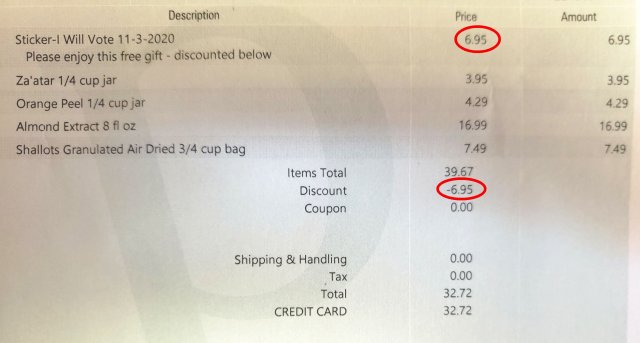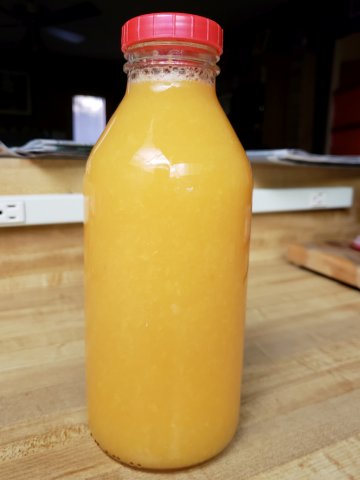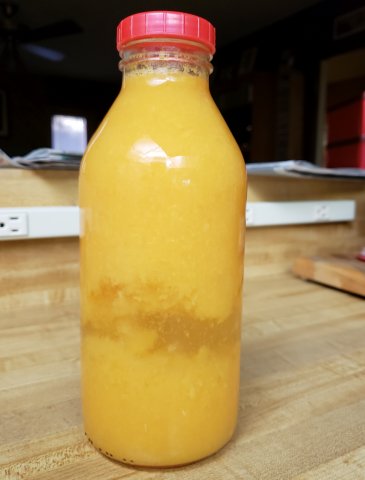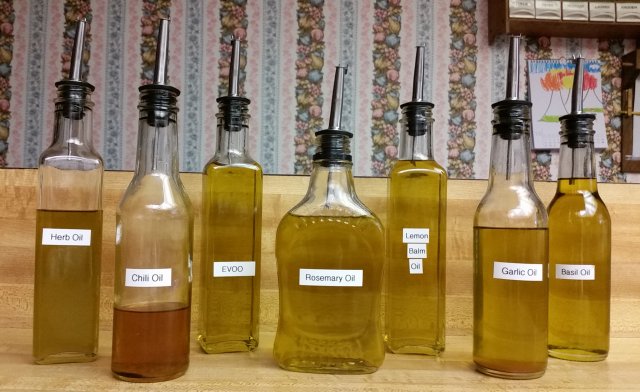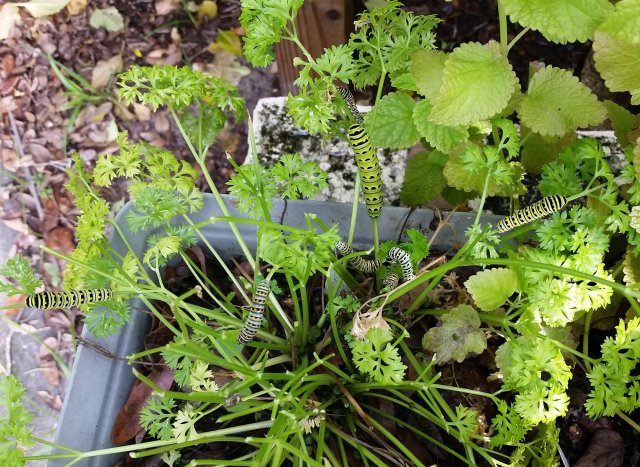Overall, I'm a big fan of Chick-fil-A. It's the exception to our policy of not eating fast food except when travelling, and even then other fast food restaurants are likely to get our business only when Chick-fil-A isn't available.
Friends who have worked for the company have praised the atmosphere and working conditions. Their workers are friendly and always respond to "thank you" with a cheery "my pleasure!" The restaurants tend to be clean and welcoming. We found that to be true even on our most recent travels along I-95 through Georgia when demand was so high the line snaked through much of the restaurant. Let me repeat that: It was clean—including the restrooms. On I-95. In Georgia.
But none of that is what keeps me coming back.
It's their Spicy Chicken Sandwich. There's nothing else like it.
I've tried spicy chicken sandwiches all up and down the East Coast. We seem to do a lot of Sunday travel—when Chick-fil-A is closed—and when I can, I look for spicy chicken sandwiches. For research, you know.
What we sacrifice for science! Some of the other chicken sandwiches were okay, but none so far has even hinted at being as good as Chick-fil-A's.
The inspiration for this post came from someone else who ate chicken sandwiches for science: Dennis Green reviewed some chicken sandwiches for Business Insider, and he agrees with me.
You know what's better than a chicken sandwich? A spicy chicken sandwich. In the face of uproar over a new chicken sandwich from Popeyes, I could no longer stomach the obviously superior version of the fried-chicken sandwich being left out of the national conversation. ...
I will not sit idly by as this information is suppressed by the mainstream media. Something has to be done. More chicken MUST be eaten. That's why I decided to pit Popeyes' new spicy chicken sandwich against two from Wendy's and Chick-fil-A. ...
Overall, the spicy chicken sandwich from Chick-fil-A hit all the right notes. It was fresh but not too heavy, unlike some of its decadent competitors. Wendy's may have the history, but it hasn't kept up. Popeyes had a good go at it for its recent foray. But for my money, I'm going to Chick-fil-A every time.
I'm with ya', Dennis. From your descriptions, I could have picked the winner without tasting a bite. Both Wendy's and Popeyes serve their chicken sandwiches with mayonnaise? <shudder>.
I can't say I like everything about Chick-fil-A. Their sauces, for example, I find mediocre at best. But you know what? I don't care. Because their spicy chicken is so good anything more than a little ketchup would detract from the experience. Sometimes I even skip the ketchup.
Their Spicy Chicken Biscuit was so good I never dressed it. It's the only thing I've found at Chick-fil-A to rival the Spicy Chicken Sandwich.
But that brings me to something else I don't like about Chick-fil-A: they discontinued their Spicy Chicken Biscuit. What were they thinking?
Our nephew's fiancée has just begun a career in management at Chick-fil-A. I know it will take her a while, ambitious as she may be, to get anywhere near the decision-making level, but I have great hopes: a Chick-fil-A to open in Old Saybrook, Connecticut, and the return of the Spicy Chicken Biscuit.
Are you listening, Cows?
It's been a while since I posted in my Conservationist Living category, which is this post's primary classification, though I've assigned it to several others as well.
America is going to hell, right? Everybody says so. Including a whole lot of people who fervently believe there is no such place as hell, which is an interesting conundrum. But they all believe with equal fervor that we are going there rapidly. Believer or non-believer, left-wing or right-wing, we are convinced that we're in bad shape and on course to get much, much worse. What we disagree on is the attitudes, events, actions, and pathways that are taking us hell-ward.
Believe me, I'm not immune to such pessimism. Neither are you, so I'm going to tell you a small part of the story of Dave Anderson.
The Andersons are friends of our daughter's family, from their Pittsburgh days. Dave's success at building a good life for his family while reclaiming a worn-out strip mine and putting to good use many hundreds of tons of refuse every year was featured last month in this Pittsburgh Post-Gazette article.
I made the 45-minute drive to Echo Valley Farm this week because I wanted to meet the man who’d turned strip-mined land in northwest Beaver County into 26 grassy acres on which beef cattle thrive. Mr. Anderson had told me he revived his land by mixing hundreds of thousands of used paper cups from the Pittsburgh Marathon with manure, hay, banana peels and restaurant refuse.
You'll want to read the whole article to learn about the symbiotic relationship between the farm, needing nourisment, and both private businesses and local governments, needing waste disposal, that's a win for everyone involved.
It all works because there’s something in it for everyone. Mr. Anderson said that 14 years ago, the field over my shoulder produced 6,000 pounds of hay at the first cutting. The cutting in [the] same field last year brought 37,000 pounds.
Plus, the farm is a great place to raise kids.
I ask if it’s just the two of them and he says, no, he and his wife, Elaine, have six girls and a boy. They range in age from 10 to 24. All seven of them comprise Echo Valley, a bluegrass/gospel/Celtic band, that just played in Harrodsburg, Ky., Saturday night.
Several years ago—it was probably more than ten, though I'm finding that hard to believe—we visited the budding farm for one of their many social gatherings of food, music, and fun. Kids and animals were everywhere. The children were much younger then, of course, but they were already solid musicians. Here is a more recent video of the group.
and one of my favorites from earlier, just for fun.
Mr. Anderson, an inveterate reader who doesn’t own a TV, and who also was an air traffic manager until he retired last Friday, figured out how to turn desolate land into a lush farm that supports a family of nine with 30 head of beef cattle, six miniature donkeys, 40 laying hens, two turkeys, four guinea fowl, three geese, three ducks, two Australian cattle dogs and six pups.
Not to mention a number of cats, as I recall.
I hope this brightened your day. If America is, indeed, going to hell, people like the Andersons are pulling mightily in the other direction.
Permalink | Read 1640 times | Comments (4)
Category Politics: [first] [previous] [next] [newest] Children & Family Issues: [first] [previous] [next] [newest] Food: [first] [previous] [next] [newest] Conservationist Living: [first] [previous] [next] [newest] Inspiration: [first] [previous] [next] [newest]
When I lamented my love/hate relationship with Penzeys Spices, one of my readers pointed me to an alternative spice source. I wasn't particularly looking for a new source at the time, having resigned myself to making do with grocery store spices except when Penzeys had a very, very special sale—which they seem to do every time Bill Penzey wants to point to a spike in sales as evidence that his customers support a particular political position.
But I checked out The Spice House and was blown away. I had not known the greater Penzeys story: It was Bill Penzey, Sr. who started the original Spice House company. His daughter took over the business, while his son, Bill Penzey, Jr., started his own spice company. Both companies have access to the old family recipes. The Spice House is smaller and more local than Penzeys, which they count to their advantage, all their spices still being prepared by hand in small batches, at their store.
The biggest difference between Penzeys and The Spice House is in politics. For all I know, the owners of the two stores share the same exact political views—or perhaps they are poles apart. I wouldn't know, because, unlike Penzeys, The Spice House makes a point of welcoming customers of all political persuasions, and keeping a very low profile themselves.
Here at The Spice House we are strictly a community of folks who like to cook; you will never get any lectures from us that include our personal agenda. We are just about the love of cooking and getting you the best possible ingredients to produce the most flavorful results!
Penzeys-quality seasonings without the side order of vituperation? I'm in!
My first order with The Spice House was just large enough to qualify for free shipping, because I'm trying to draw down my current spice stockpile, but what I've seen so far, I like very much. Here's a new blend that quickly became a favorite: Lake Shore Drive Seasoning: Gently hand mixed from salt, shallots, garlic, onion, chives, ground green peppercorns, scallions. My favorite alliums all together! I could only be happier if they had—without replacing this one—a blend that included all of the above except the salt, so I could add still more of the flavor to a dish.
I doubt The Spice House will totally replace Penzeys for me, as not all blends are available in both places. But it has certainly become the go-to store for my regular seasoning purchases.
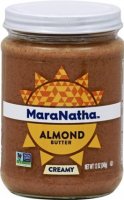
Almond butter. I should have asked this question before I bought it: Does anyone here use almond butter? Tell me about it.
I like almonds and really, really like marzipan. Almond paste is an ingredient I like to keep in pantry, even though it's not inexpensive. It's essential for making almond raisin bread, one of my favorites.
Thus the idea of almond butter intrigued me. I was envisioning something that looked like peanut butter but tasted like almond paste. Sort of like Biscoff (Speculoos), perhaps, but with a marzipan flavor. That would have been awesome.
I'd been put off by the price of almond butter, so when Publix offered this on a buy-one-get-one-free sale, I jumped at the chance. Now I'm stuck with two jars of something that tastes rather like bad peanut butter. Don't get me wrong; I like peanut butter. But when one is expecting almond, peanut doesn't cut it—especially not at an almond price.
The ingredients don't seem unreasonable: dry roasted almonds, organic evaporated cane sugar, palm oil, sea salt. I'm going to try it in some recopies to see if it tastes better than by the spoonful, but I'm not particularly hopeful.
My take? If you're allergic to peanuts (but not almonds), and really want a substitute for peanut butter, this would work well. Otherwise, forget it.
What's your experience? Did I get a bad jar? A bad brand? Or just make a bad assumption about what almond butter should taste like?
I have a new favorite cooking show, and no one is more surprised than me. It's called Struggle Meals and features a crazy young person (probably one of those Millennials, born on Bastille Day in 1990, somewhere between our youngest daughter and our oldest nephew) whose audience is a world vastly different from my own, a world of potty-mouthed youngsters who claim to be struggling financially yet who almost never cook at home, preferring restaurant food, most often in take-out or food-truck form, because they "don't have time" to do otherwise. They probably also pay for cable TV, but that's a rant for another time. In any case, I'm clearly not his intended audience.
But hey, food is food! Cooking is cooking, and Struggle Meals is full of great ideas. Frankie Celenza is highly entertaining (if also, like much of his audience, a bit of a potty-mouth), and the Struggle Meals shows are short (five to fifteen minutes) and to the point. The link above takes you to the YouTube channel, but if you have access to Facebook, you can follow Struggle Meals there, with the advantage that the comments always include recipes for his featured dishes.
The point of the show is that inexpensive, high-quality, homemade food is within reach of almost everyone. Each show features the creation of (usually) three attractive, healthful meals on a theme (such as wraps, chicken, coconut, breakfast, street food, etc.), all of which can be prepared with minimal effort for under $2 per serving. And without special equipment: for example, he uses the "Struggle Whisk 9000"—a fork. Or "Struggle Plastic Wrap"—a plate on top of a bowl.
One feature of most of the shows is his famous "packet drawer," which is where I first got the hint that his audience lives on take-out food. Frankie has one kitchen drawer dedicated solely to those tiny packets of soy sauce, sugar, butter, mustard, mayonnaise—even sriracha—that usually come in excess with take-out orders. This is "free flavor" and he makes liberal use of it, a significant savings of both money and food over tossing them into the trash. "Normal people" won't have this resource, but that doesn't hinder the recipes—nor the fun—in any way.
Here's an example, Episode 1 of the first season. Warning: gratuitous violence in the introduction. I've learned where to close my eyes.
I fell in love with Penzeys Spices the first time I walked into their Pittsburgh store, many years and ten grandchildren ago. What an enormous array of herbs, spices, and extracts of excellent quality, as well as their own superb spice blends! I couldn't say enough wonderful things about Penzeys, in person and here on this blog.
You may or may not have noticed that I don't do that anymore. My interactions with the company have left a bad taste in my mouth, and when your business is selling food ... that's not a good situation.
Once upon a time I stocked up on Penzeys products whenever we visited our daughter in Pittsburgh. I put myself on their mailing list, and in between times would sometimes place an order through the mail. But imagine my joy when Central Florida finally got its own Penzeys store! We generally visited once a month, to take advantage of the free spice coupons in the catalog, and of course we almost always made other purchases as well.
Ah, the catalog. In each one, Bill Penzey wrote an enjoyable little column about spices, food, cooking, and family. I used to like reading that, almost as much as I enjoyed the food & family stories contributed by customers. But gradually, that changed. Politics started to infuse the catalog, first in Bill's column and then in the customer stories he chose to include.
Well, I don't usually discriminate against great products based on the political opinions of the company. I continued to drool over the catalog, skipping Bill's column. When I did read it, I was usually sorry I had. We continued our monthly visits to the store, where even the employees rolled their eyes at the political turn the company was taking.
And then Penzeys closed our store.
I understand that companies must make difficult economic decisions and sometimes stores must be closed. I'm okay with that, even if it makes me sad. Their lease was up, and rents are high in the area they had chosen to open their store. What my anger flowed from was the implication on their sign that they would soon be opening a new store in the area, though I certainly was looking forward to that.
You see, in his political writings Bill Penzey consistently positions himself and his company as the defenders of the common people, the little guys, the poor and needy ... you get the picture. He's always denouncing people and businesses that make decisions based on what he perceives as selfishness and greed. Yet he decided to close a store and reopen elsewhere just to get his company out from under an expensive lease, leaving his employees—the little guys, the poor and needy common people—high and dry. They could not afford to wait for the opening of a theoretical new store: they needed jobs. Given all Bill Penzey has said about what other people should do with their money and in their own businesses, I would have expected his company to bite the bullet, forgo some profit, and at the least not close the existing store until a new one, nearby but in a less expensive neighborhood, was ready to provide jobs for their displaced employees.
They did not. That moves the scenario from necessary business decision straight to hypocrisy. And as it turned out, it has been four years since they closed, and there is still no sign of a Penzeys store any closer than Jacksonville.
On top of that, despite my many attempts at communication—before and after this event; whether contribution, compliment, or complaint; by e-mail or postal mail—I never heard back from Penzeys. It was worse than writing to a politician and expecting communication!
Since then, Bill Penzey's political rants (which now come to me by e-mail rather than printed catalog) have gone over-the-edge extreme. The hypocrisy, the hate-preached-as-love, would almost be funny—if it weren't so sad.
The following incident did make me laugh, at least until I started wondering what tax advantage the company might be angling for. Last Friday, the mailman delivered a box of excitement: my most recent Penzeys order. Penzeys packages often come with a freebie or two tucked in, such as sample-sized envelopes of herbs or spices (my favorite) or something advertising the store or one of Bill Penzey's pet causes. Here's one of the latter that came this time:
It's a sticker, no big deal except for the waste when it ends up in the landfill. What makes it bizarre is how it appeared on the packing slip, which you can see below, with some prices I've circled in red.
For this sticker, which I didn't order, they charged me $6.95, then "discounted" the price at the end. What kind of pricing is this? Who in his right mind would pay $6.95 for a sticker, let alone one not even worth sending to grandchildren? And what's the point? Some sort of shady accounting practice or tax benefit?
Amusing in a different way are the accolades Bill Penzey gives himself by first (1) making an extreme political statement, then (2) offering an extraordinarily good sale, 'way too good to pass up, then (3) bragging that his customers clearly endorse his political beliefs—just look at the spike in sales!
But do you know what? I still buy his spices. Not nearly as much, not nearly as often. As I said, the company now leaves a bad taste in my mouth. But the taste of the spices is still wonderful. I don't believe boycotts to be generally useful, and in most cases I choose businesses by quality and price without asking about politics.
Penzeys' reputation for quality is no doubt why they feel they can get away with repeatedly and consistently alienating half their customer base. It puts me in mind of what a math professor friend said about Harvard University years ago: The quality of education at the school has gone down significantly; students are no longer getting what a "Harvard education" used to mean. Harvard is living on its reputation. And that will be slow to die, because the Harvard reputation will still give Harvard graduates' résumés a great advantage over others. More importantly, it will continue to attract the best students, which will give them both the "iron sharpens iron" benefit and an unbeatable network of connections for the future. You can't live forever on reputation alone, but if you have once been great, you can fool yourself and others for a long time.
I believe Bill Penzey is fooling himself. As long as Penzeys' spices are perceived as superior—and many of them really are—even the spurned, denigrated, vilified half of his customer base will not flee en masse. But many—like some students who forgo applying to Harvard—may decide that the difference is not worth the cost. The love and the loyalty are gone.
Update 10/16/19: Note that this post has garnered enough comments to spill over past the first page. Click on the Next link to see the more recent ones.
My brother used to tell me that drinking orange juice was no better than drinking Coke, as it was no better than sweetened water.
Being a Floridian, that has rankled ever since.
It was brought to mind recently in a discussion with my nephew, the medical student, in which I heard him say that the recommendation for drinking juice was no more than two or three times a week. I may have heard the details wrong, because I don't see that when I look online for official recommendations, which are a bit more generous. Or it may be the newest medical-school thinking that hasn't yet been set in stone. But the upshot of the discussion was that whole fruits are good for you and should be encouraged, while fruit juice is bad for you, with no real benefits, and should be severely restricted. This opinion piece in the New York Times is an example of the bad rap juice is getting.
The doctors have good intentions, but I wouldn't be surprised if the real impetus behind this negative attitude towards juice comes from those who want to push soda consumption. After all, if orange juice isn't any better than Coke, why not drink Coke for breakfast, as the granddaughter of an acquaintance used to do?
The real question is: Why is juice so radically different from the whole fruit from which it is (supposedly) made, that the recommendations for consumption are polar opposites?
My answer is that what is called juice these days may have started as fruit, but has been so processed—strained, filtered, heated, added to and subtracted from, torn apart and put (somewhat) back together—that its source is no longer recognizable. Consider the following products:
- Oranges, freshly-picked from the tree, and reamed to extract the juice and much of the flesh
- Fresh orange juice that has not been pasteurized (I can buy this at local specialty stores, and also at Costco!)
- "Not from Concentrate" orange juice from the grocery store, which has been processed and pasteurized but at least looks like orange juice because it includes pulp
- #3 but without any pulp
- #3 or #4 with calcium added
- Orange juice from concentrate (John McPhee's book, Oranges, has a graphic description of what happens in that process)
- Orange juice drink, orange drink, orange-flavored drink, and other designations of something that may or may not have some real orange juice in it
- Tang and other pseudo-orange beverage mixes
The legal definitions are fuzzy—it's amazing what you can do to a product and still call it "orange juice"—and doctors rightly draw a line between #6 and #7, but say "orange juice" to the general public, and you could evoke thoughts of any of the above.
As far as I'm concerned, the list is in decreasing order of flavor. I suspect it is also in decreasing order of nutrition. But this definition of "juice" is so broad, even if you exclude #7 and #8, that it's useless. What do the doctors mean when they say "fruit is good, juice is bad"? Are they even considering how slippery the definition is?
This is orange juice.
It is juice I squeezed from oranges Porter picked from our own Page orange tree. Technically, the above statement is incorrect, because the Page orange is not a true orange, but a hybrid developed in Orlando in the 1940's that is 3/4 tangerine and 1/4 grapefruit. I should have said, This is citrus juice. I have no idea what the Food and Drug Administration would call it. I call it delicious.
Drinking this juice is not the same thing as eating the fruit, I'll grant. Some of the membranes are left behind in the juicing process. But a lot gets through, as you can see in this picture of the juice before I shook the bottle.
I'd say the experience is pretty close to eating the fruit. I acknowledge that the experience of drinking processed, grocery-store juice is radically different from that of eating fruit. However, the problem is not in the juice. The problem is in the processing, and the labelling.
Don't fight to eliminate juice. Fight to bring back real food!
As usual, when I make a longish comment on a Facebook meme, I hate to waste it, but use it here as well. This one struck a nerve.
I abide by both vaccine recommendations and food recalls,
but the CDC can pry raw cookie dough out of my cold, dead hands.
Amen to that. If a food system is so broken that even flour and eggs must be cooked to be safe to eat, you don't meekly comply, you FIX THE SYSTEM. Seems a matter of national security to me!
Anyone who has tasted the difference that even simple pasteurization makes in food—milk, orange juice, cider—knows what heating does to flavor. I'm from upstate New York, and I know what cider is supposed to taste like. The pasteurized [fill in your own noun] available now doesn't deserve the name.
I've said it before: I'm convinced that a good part of the obesity problem in America is that we are unconsciously searching for the FLAVOR that mass-produced, heavily-processed foods have lost. National security again.
Don't get me wrong, however—I love cookies after they're baked, too. I'm a big fan of the Maillard Reaction as well as of raw food.
We had a deep fryer once, long ago, and I found the whole process messy and rather more of a pain than it was worth. However, having recently experienced some really amazing fried food at the Melting Pot, I thought I'd investigate what new technology might now be available. (Who knew that deep-fried kale would be so awesome?)
I haven't made up my mind about anything yet. What holds me back the most is knowing I'd have to find a place to store a new appliance.
Be that as it may, look what I found in a review of the Presto Cool Daddy 6-Cup Electric Deep Fryer:
- Ideal for a small family up to six people.
I like the way they think.
Revealing my age, I can say that I remember the days when a family of six was considered small; now our children's families (of six and eight) attract attention wherever they go.
Back then we didn't have Presto fryers, nor frozen French fries: my mother made fries for our (small) family of six starting from whole potatoes, and using a pot of oil on the stove. And they were so good! As time went on, she did switch to using frozen French fries, which was definitely easier, though not better.
Does anyone have thoughts about deep fryers to share? I'm interested—if I am interested; I'm still not sure—in something small, since our current household is small by any standards (two).
Many of my friends are long-time fans of extra virgin olive oil, or EVOO as they call it. I've felt the pressure to use this "healthy" oil, but had always dragged my feet. Olives, to put it plainly, nauseate me. It would be much more convenient if I liked them, but I don't.
Nonetheless, over the span of a year or so I was able to train myself to tolerate EVOO. Then in 2016 I discovered the oil from California Olive Ranch, which not only passed the tests of quality and freedom from Italian Mafia interference (I hope that's still true), but tasted great. I've never looked back.
I've moved forward, too. Combine my new love of EVOO with an overflowing herb garden and the desire to not waste its bounty, and you get this:
Making an olive oil infusion is easy and fun. I clean the herbs, put them in a bottle, and pour EVOO on top. The bottles you see here are not the ones I use to make the infusions, which have larger mouths. After a few days, I strain the oil into the dispenser bottles. These bottles are some I had on hand (previously holding oil, vinegar, even maple syrup), chosen for neck sizes that would fit my pourers, which are Cuisenart, purchased from Bed, Bath, and Beyond.
For the garlic oil, I tried crushing the cloves for one batch, and chopping them for the next. I think I prefer chopping, despite the smaller surface area, because it makes the oil less cloudy—though still not as clear as the other varieties.
Our jalapeño crop did not come through this year, but the chili oil came out just fine using dried red pepper flakes.
The one herb you might not be familiar with is lemon balm. I started out with a small batch, because I didn't know how I'd like it. It has turned out well, adding a brightness to food without increasing acidity.
The bottle labeled "herb oil" is a mixture of rosemary, basil, oregano, lemon balm, garlic, and peppercorns (this time; it will be different as the garden changes). No particular quantities, just what came from trimming our plants. It's wonderful as a dip for good bread. I suspect that with some balsamic vinegar it would also be lovely on a salad.
All the oils have been great to have on hand for cooking. I would say my efforts to embrace extra virgin olive oil have paid off handsomely.
I thought my success might make me more favorably inclined to olives themselves, but that goal still eludes me.
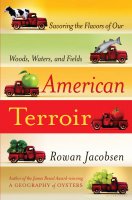 American Terroir: Savoring the Flavors of Our Woods, Water, and Fields by Rowan Jacobsen (Bloomsbury, 2010)
American Terroir: Savoring the Flavors of Our Woods, Water, and Fields by Rowan Jacobsen (Bloomsbury, 2010)
Score one more for my sister-in-law's library book sale sense, though why the public library in Simsbury, Connecticut saw fit to discard this excellent book is unfathomable. The author of the Fruitless Fall and Chocolate Unwrapped has produced another beautiful book about food, reminiscent of both John McPhee's Oranges and Michael Pollan's Cooked.
My generation grew up on standardized food. Living in Upstate New York, I knew that apple cider was a living drink of complex and unmatched flavor, bearing zero resemblance to the apple juice on grocery store shelves. I knew that the flavors in the blueberries I picked from a friend's farm were so far from those available in the mass market that they ought not to be sharing the same name. It was years, however, before I realized that the same was true of milk, orange juice, bread, oil, lettuce, and other dietary staples. We have not entirely sold our birthright for a mess of pottage—making inexpensive foods available to those who live away from the source is a good thing—but the loss of flavor and variety may bear some responsibility for the rise of obesity: we are eating more and enjoying it less.
Searching for the role of place—soil, climate, altitude, farming practices, and other environmental factors—on iconic North American foods, Jacobsen's essays cover maple syrup, coffee, apples and apple cider, honey, potatoes, mussels, wild forest foods, oysters, avocados, salmon, wines, cheese, and chocolate.
American Terroir is good all through, but the first sip was the best: the chapter on maple syrup.
Anybody can make the late-season treacle, but pulling off a batch of super-delicate Fancy requires skill, experience, and luck. You have to use the first sap runs of the year, which are higher in sugar content and thus require less boiling, because the longer you boil syrup, the darker it gets. And you have to boil right away, because if sap sits, microorganisms flourish in it, and these "impurities" are what make the syrup dark and strong....
Of course, nobody really cares except the handful of remaining maple sugar manufacturers and the old-time New Englanders who continue to go to great lengths to keep flavor out of their syrup. Until recently, they even charged more for it—a really bizarre situation, since most everyone who didn't grow up in a sugaring family prefers the rich, chewy, darker grades....
Fancy is the color of vegetable oil, Medium Amber the color of honey, Dark Amber the color of Amontillado sherry, and B the color of iced tea. Commercial, which has the color and flavor of motor oil, can't be sold retail and is shipped by the barrel to the packaged-food industry for products "made with real Vermont maple syrup."
The chapter on apples is fascinating, but also disappointing. Jacobsen correctly makes the point that pasteurization and the loss of heirloom apple varieties have ruined what the grocery stores call "apple cider," but he errs in insisting that the only brew worthy of that name is alcoholic. Of the apple's ambrosial nectar—cider that is unpasteurized, unfiltered, and made from small, old-fashioned apples with unfamiliar names—he makes no mention at all.
Reading what Jacobsen learned about coffee almost made me want to start drinking the stuff. Reading about wine, on the other hand, nearly had me taking the pledge.
Few wines make it through the chop shop untouched. Yet none of this is revealed by the label. Wine is not, according to the U.S. government, a food, so the Food and Drug Administration has no jurisdiction over it. The Alcohol and Tobacco Tax and Trade Bureau, which has never been big on ingredients lists, does. The only thing a wine label need reveal is the presence of sulfites, which are added to all but organic wines....
Here's the label I'd really like to see: "At Wacky Wallaby Wines, our lifeblood is selling wines in the United States at 5.99 a bottle. A couple of years ago we tried raising our price to $6.99, but we lost market share to Chile, so $5.99 it is. To survive at that price point, we scour Australia for the cheapest grapes we can find, and we buy them in massive quantities, which allows us to really shaft the growers for every nickel. All those grapes come from vineyards that maximize yield, meaning there isn't a whole lot in them other than sugar and water. Unsurprisingly, these grapes tend to make wine that tastes like Hi-C with grain alcohol sprinkled over the top. But here's where we at Wacky Wallaby go the extra mile so that you, the consumer, can have drinkable wine for the price of a Double Whopper meal deal. We start by dusting the juice with powdered acid, the better to approximate the fresh juiciness of Hi-C, plus a quick shot of Ultra Red to give it the inky blackness that usually only comes from low-yielding, expensive vines. Next we order a yeast, developed in Australia's finest lab, that gives the aromas of jam and chocolate to red wines. (Taste tests have shown that you, the consumer, really, really like anything that tastes like chocolate.) We use sulfites to kill any indigenous yeasts in the juice (indigenous yeasts can be so unpredictable), then add the choco-yeast and ferment the juice. The resulting wine is wildly alcoholic because the sugar content of the grapes is so high (hey, that's what happens when you grow vines in a dessert!), so we throw it in the ol' reverse-ossy [reverse osmosis] and remove enough alcohol to drop it to a drinkable 14 percent. We could go further, but you, the consumer, have shown that you like to get hammered. Independent studies have also shown that you actually prefer the taste of Hi-C to that of wine, so our next move is to push the flavor profile in that direction. To soften that rough, tannic taste of red wine skins, we micro-oxygenate. The same thing would happen naturally if we stuck the wine in our cellar and let it age for six years, but we at Wacky Wallaby have to service our debt long before then, so micro-oxygenate it is. Next, we shovel mountains of wood chips into the vat to give a vanilla flavor. And you, the consumer, have shown that the only flavor you like even more than chocolate is vanilla. You like it in everything, and, much to even our shock, you like more than we ever could have imagined. So on those rare occasions when we suffer an attack of standards and consider stopping, we remind ourselves that wineries are going under right and left, and we start shoveling wood chips again. Our commitment to you, the consumer, is that we will follow you to the vanilla-candle-scented ends of the earth if it makes you happy!"
Maybe I won't take the pledge after all. On another front, the Prohibitionists have a lot to answer for.
From a riotous diversity of form, color, and flavor, reflecting the multitude of ends we asked the apple to meet—food, dessert, refreshing drink, inebriator—the apple tree suffered a biodiversity crash in the nineteenth century, brought down by the temperance movement. The campaign to chop down every cider tree drove cider underground and impoverished the drink in a way it is only now recovering from. The apples that survived the purge were the ones that could legitimately claim to be for eating, not drinking. Most of the tannic, astringent apples disappeared, replaced by apples with abundant sugars and enough acid to keep things interesting.
American consumers are not without fault.
It turns out that, given a choice, people overwhelmingly go for the reddest apples. So growers kept selecting for the reddest. They were not, however, selecting for the tastiest. Eventually, Red Delicious apples eclipsed fire-engine red and reached a color imaginatively described by the industry as "midnight red." And most are virtually inedible, with dry flesh and thick skin. Good-tasting apples have small, tightly packed cells that break apart at first bite, spilling their juice in all directions. Red Delicious have cottony, dry cells with too much air in between. This has not been lost on the industry, but until recently, it didn't care. The mealiest Red Delicious outsold the tastiest McIntosh. Why not give the people what they want?
Did you know this?
Today China dominates the apple business, with more than 60 percent of world production. The second-place United States is a speck in China's rearview mirror, with 6 percent, two thirds of which comes from Eastern Washington.
I had the sense to birth Heather during apple season; why is it that her family celebrates half of their birthdays in February? We seem to have developed a pattern of visiting New Hampshire in either the hottest part of the summer or the coldest part of the winter. It's high time we broke the pattern, because New Hampshire has some of the most wonderful apples ever, no matter what Eastern Washington might think.
For my taste, American Terroir's finish is not as strong as its beginning, probably because he is unkind to dark chocolate. That's a pattern throughout the book: the best and most interesting flavors are found in the lighter versions of food: Fancy grade maple syrup, lightly roasted coffee, and chocolate without the compounds that give dark chocolate its signature flavor (and its health benefits).
Two other patterns stand out, repeated over foods as diverse as the book:
- Consistently, the best-tasking food is produced under stress. Altitude, temperature, climate—an easy life leads to bland fruit. Struggle produces character. What doesn't kill you makes you—or at least your children—interesting.
- Yuppies, rich people, capitalists, and food snobs: we love to hate 'em. But it is their tastes, their interest, their efforts, and their money that are rescuing and promoting low-volume farmers and businesses, heirloom (read: flavorful) food varieties, and healthy, sustainable practices. The rest of us only perpetuate our factory-farmed, monoculture-crop system, because—well, because who in his right mind would pay that kind of money for a cup of coffee, a bar of chocolate, a piece of cheese, or an apple?
There are at least nine swallowtail caterpillars here. I need to find a butterfly that likes lemon balm (currently overgrowing the parsley).
Rooftop hydroponic gardens. Pretty cool.
I'm not totally convinced that hydroponic growing gives a plant everything a good soil does—I can't help thinking of it as baby formula for plants—but there's a lot that's good about this approach, and what are the odds most of our commercial vegetables are grown in good, natural soil anyway?
 There's a Sushi Eatstation in one of our local shopping centers. I'm not generally a fan of strip mall food, and bad Asian food can be ... really bad. So I was initially suspicious of this design-your-own, food-fusion, fast-food restaurant. I mean, how weird is it to be able to make sushi with chicken, sweet potates, and bacon?
There's a Sushi Eatstation in one of our local shopping centers. I'm not generally a fan of strip mall food, and bad Asian food can be ... really bad. So I was initially suspicious of this design-your-own, food-fusion, fast-food restaurant. I mean, how weird is it to be able to make sushi with chicken, sweet potates, and bacon?
But today we decided to check it out. And am I glad we did.
We were too overwhelmed by the choices (check them out yourself) to design our own on this first visit, so we chose the Traditional Ninja combination, in a bowl, for $12. This was white rice, salmon, tuna, krab (the standard sushi fake crabmeat), cucumbers, avocado, scallions, masago, tempura flakes, seaweed salad, sesame seeds, nori seasoning, ponzu, and sriracha, to which our server added some ginger and wasabi.
The large bowl was plenty for the two of us, though it was so good I could easily have eaten it all myself.
Was it traditional? No. Was it an awesome sushi experience? No. Was it a delicious flavor and texture experience? Absolutely. Will I return to the Sushi Eatstation? I certainly hope so!
It was an irresistable headline: Nutritionist claims pizza can be a healthier breakfast than cereal.
I love breakfast. I could eat it for breakfast, lunch, and dinner. My current favorite morning meal is a large bowl of steaming oatmeal with dried fruit, though that may change with the weather.
Make that second-favorite. Pizza is always at the top of the list.
Blogger and dietitian Chelsey Amer caused a stir when [she announced] that a greasy slice of pizza is healthier than a bowl of cereal with milk. "You may be surprised to find out that an average slice of pizza and a bowl of cereal with whole milk contain nearly the same amount of calories,” Amer said. “However, pizza packs a much larger protein punch, which will keep you full and boost satiety throughout the morning."
Not that this is news to me, though it's nice to hear a nutritionist say it. The writer of the article, however, is less than enthusiastic, and spends most of his effort convincing us of ways to make cereal healthier.
New York-based dietitian Keri Gans says that cereal can be a perfectly healthy breakfast option — yes, healthier than pizza — as long as you’re smart about it. ... "If you choose the right cereal that’s packed with fiber, it may help lower cholesterol and control blood sugar. ... You could top your cereal with berries, which are rich in vitamins. ... you [can] work plenty of nutrition into your bowl — far more than you’d find on a dollar slice."
Well, sure, if you want to load the equation in favor of cereal. But you can do the same thing for the pizza. Skip the fast food version. Homemade pizza, whole-grain crust, good tomato sauce and cheese, lots of veggies.... But don't forget the pepperoni, if—like me—you consider it nearly essential to good pizza. Don't skimp on flavor, or it won't be satisfying and you'll eat more.



